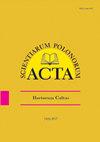龙角菜在RITA®生物反应器中的优化生长及富含多酚提取物的生物活性初步筛选
IF 0.7
4区 农林科学
Q4 HORTICULTURE
引用次数: 1
摘要
龙头草是一种生长在中国的药用植物。本研究的目的是在预先优化的Murashige和Skoog (MS)培养基中添加0.5 mg/L n -苄基-9-(2-四氢吡喃基)-腺嘌呤(BPA)和0.2 mg/L吲哚-3-乙酸(IAA)和物理(蓝色LED)条件下,在临时浸泡体系中大规模培养林松转化芽。在RITA®生物反应器中生长3周后,对芽的增殖、生物量和次生代谢物积累进行了评估。采用高效液相色谱法(HPLC)测定了四种提取物(氢甲醇提取物-甲醇含量分别为20%、50%和80%的混合物)中多酚的含量。在三周内,培养的生物量增加了283倍,每个外植体的增殖率为40.5个芽或芽。从原料中提取酚类化合物的最佳溶剂为80%的甲醇溶液;多酚含量最高,为40 mg/g DW(干重),其中沙棘糖苷(12.97 mg/g DW)和迷迭香酸(10.68 mg/g DW)居多。培养物生物量的密集生长使每升培养基中可获得570毫克多酚化合物。采用三种自由基清除试验和脂质过氧化抑制试验,评价了林前芽提取物的抗氧化能力。在研究中,还测定了提取物的细胞毒、抗菌和抗真菌潜能。本文章由计算机程序翻译,如有差异,请以英文原文为准。
The optimization growth of Dracocephalum forrestii in RITA® bioreactor, and preliminary screening of the biological activity of the polyphenol rich extract
Dracocephalum forrestii is a medicinal plant growing in China. The aim of the present study was to large-scale cultivation of D. forrestii transformed shoots in a temporary immersion system based on previously-optimized Murashige and Skoog (MS) medium supplemented with 0.5 mg/L N-benzyl-9-(2-tetrahydropyranyl)-adenine (BPA) and 0.2 mg/L indole-3-acetic acid (IAA) and physical (under blue LED) conditions. Shoot proliferation, and biomass and secondary metabolite accumulation in the shoots were assessed after a three-week growth period in a RITA® bioreactor. The levels of polyphenols in four types of extract (hydromethanolic extracts – mixtures with a 20%, 50%, and 80% methanol content and infusion) were determined using high-performance liquid chromatography (HPLC). Within three weeks, the culture increased its biomass 283-fold, with a proliferation ratio of 40.5 shoots or/and buds per explants. The most efficient solvent for extraction of phenolic compounds from raw material turned out to be 80% methanol solution; the highest polyphenol content was 40 mg/g DW (dry weight) with acacetin rhamnosyl-trihexoside (12.97 mg/g DW) and rosmarinic acid (10.68 mg/g DW) predominating. The intensive growth of the biomass of the culture allowed 570 mg of polyphenolic compounds to be obtained per liter of the medium. The antioxidant potential of extract of D. forrestii shoots was evaluated using three free radical-scavenging tests, and the inhibition of lipid peroxidation assay. In the study, the cytotoxic, antibacterial and antifungal potentials of the extract were also determined.
求助全文
通过发布文献求助,成功后即可免费获取论文全文。
去求助
来源期刊
CiteScore
1.30
自引率
14.30%
发文量
61
审稿时长
4-8 weeks
期刊介绍:
In Acta Scientiarum Polonorum Hortorum Cultus we publish original research papers and review articles containing new and significant information on broad aspects of horticulture and related disciplines. The papers are published in English only, in six issues yearly.

 求助内容:
求助内容: 应助结果提醒方式:
应助结果提醒方式:


